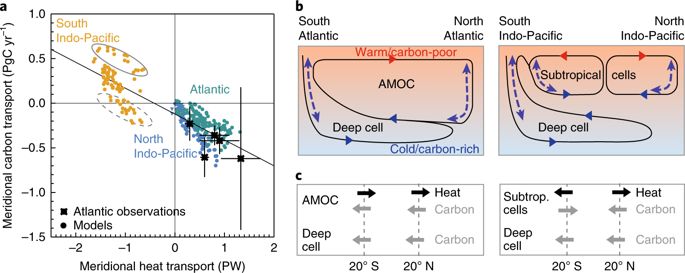Nature Geoscience ( IF 15.7 ) Pub Date : 2018-06-11 , DOI: 10.1038/s41561-018-0151-3 L. Resplandy , R. F. Keeling , C. Rödenbeck , B. B. Stephens , S. Khatiwala , K. B. Rodgers , M. C. Long , L. Bopp , P. P. Tans

|
Measurements of atmospheric CO2 concentration provide a tight constraint on the sum of the land and ocean sinks. This constraint has been combined with estimates of ocean carbon flux and riverine transport of carbon from land to oceans to isolate the land sink. Uncertainties in the ocean and river fluxes therefore translate into uncertainties in the land sink. Here, we introduce a heat-based constraint on the latitudinal distribution of ocean and river carbon fluxes, and reassess the partition between ocean, river and land in the tropics, and in the southern and northern extra-tropics. We show that the ocean overturning circulation and biological pump tightly link the ocean transports of heat and carbon between hemispheres. Using this coupling between heat and carbon, we derive ocean and river carbon fluxes compatible with observational constraints on heat transport. This heat-based constraint requires a 20–100% stronger ocean and river carbon transport from the Northern Hemisphere to the Southern Hemisphere than existing estimates, and supports an upward revision of the global riverine carbon flux from 0.45 to 0.78 PgC yr−1. These systematic biases in existing ocean/river carbon fluxes redistribute up to 40% of the carbon sink between northern, tropical and southern land ecosystems. As a consequence, the magnitude of both the southern land source and the northern land sink may have to be substantially reduced.
中文翻译:

根据对海洋和河流碳迁移的重新评估,修订全球碳通量
大气中CO 2的测量集中度对陆地和海洋汇的总和提供了严格的约束。该限制条件已与海洋碳通量和河流碳从陆地向海洋的运输以隔离陆地汇的估算结合在一起。因此,海洋和河流通量的不确定性会转化为陆地汇的不确定性。在这里,我们对海洋和河流碳通量的纬度分布引入了基于热量的约束条件,并重新评估了热带地区,南部和北部热带地区的海洋,河流和陆地之间的分配。我们表明,海洋翻转环流和生物泵将海洋中半球之间的热量和碳的运输紧密地联系在一起。利用热量和碳之间的这种耦合,我们得出了海洋和河流的碳通量,它们与热传输的观测约束兼容。-1。现有海洋/河流碳通量的这些系统性偏差在北部,热带和南部陆地生态系统之间重新分配了高达40%的碳汇。结果,可能必须大大减少南部陆地源和北部陆地汇的规模。






























 京公网安备 11010802027423号
京公网安备 11010802027423号